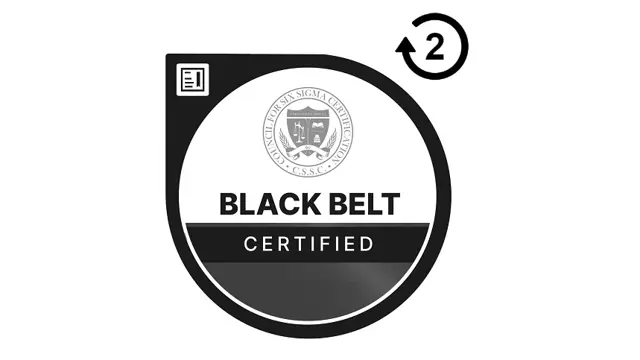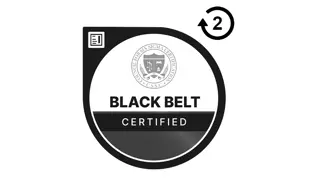
Accredited CSSC Lean Six Sigma Black Belt (exam included with retake) – 6 Months Access
Certified by the Council for Six Sigma Certification (CSSC)
Hudson
Summary
Spread the course cost, interest free, over 6-months at less than £110 per month.
- CSSC Lean Six Sigma Black Belt - Free
Add to basket or enquire
Overview
Key Points
- Provided by a CSSC Accredited Training Organisation (ATO): Hudson
- Exam fee included to sit the official CSSC exam and gain your certification from the Council for Six Sigma Certification (CSSC)
- Exam retake in the event you fail the exam on the first attempt
- We give you 12-months to use your exam retake after you fail the first time
- Official exam can be sat at home or in the office
- Upon successful completion of the final exam, you will receive a certification from the CSSC confirming you are fully lean six sigma black belt certified
- 6 months access to course material
- Certification has no expiration date – renewal is not required in the future
- No prerequisites or project requirements to take the course
- All certifications contain a verifiable certification number that can be validated by employers on the CSSC official register
Core Content
- Video based course material: Fully narrated by the tutor, this includes hundreds of illustrations, graphics, charts, diagrams, and added animations to illustrate learning concepts.
- Official CSSC lean six sigma black belt certification training manual
- DMAIC case studies: We have developed illustrated PDF case studies covering one topic from each DMAIC phase to help solidify your knowledge of the six sigma methodology.
- Video based project case study: This is a narrated case study focusing on the application of DMAIC tools and concepts in a commercial setting.
Assessments
- Interactive knowledge checks: As the name suggests, these are interactive knowledge checks – using drag and drop functionality. It’s a fun and easy way to help you grasp DMAIC.
- Interactive DMAIC simulation: This is an animated and narrated simulation of a six sigma project. You are prompted to choose the correct course of action throughout your project journey.
- Interactive quizzes: Test your knowledge after each DMAIC phase with this multiple choice set of quizzes.
- Practice test papers: These downloadable practice test papers will help prepare you for the final six sigma black belt exam.
- CSSC Exam: The exam fee is covered in the course price.
- Exam insurance included: Fail the first attempt, get another resit within 12-months of failing
Resources
- Downloadable six sigma templates: We have created a series of downloadable Excel templates that you can use during and after the course. You’ll find many of these discussed within the course. They can be used to apply your six sigma skills or utilised during a project.
- Video based Minitab DMAIC exercises: This is an excellent resource to help cement your understanding of six sigma concepts, but also help you understand how to apply your six sigma skills in the real world. After watching the video tutorials, you’ll be prompted to perform the exercises.
Course Duration
- Total duration: 157 hours
Exam retake
If you don’t feel you have an aptitude for exams, we give you the opportunity to retake the six sigma black belt exam in the event you fail on your first attempt. The exam retake must be taken within 12 months of the date you fail the exam the first time.
About the exam
The official CSSC lean six sigma black belt certification exam consists of 150 questions. It is an open-book format examination, allowing students to access resources during the exam, such as the training manual provided in this course. All students have 3 hours to complete the exam. Students must achieve a score of 420 points (or higher) out of a total 600 possible points to pass the exam.
The exam consists of multiple-choice and true/false questions from the major sections of CSSC six sigma black belt “Body of Knowledge.” The official CSSC six sigma black belt certification exam can be taken either online, at home or in the office.
Certification
Black Belt Level
Certificates
CSSC Lean Six Sigma Black Belt
Digital certificate - Included
CSSC stands for Council for Six Sigma Certification. They are the accrediting body for this course and will award the certification upon passing the exam. All certifications contain a verifiable certification number that can be validated by employers on the CSSC official register.
Description
What is six sigma?
Six sigma is a set of techniques and tools for process improvement. It was introduced by engineer Bill Smith while working at Motorola in 1986. Jack Welch made it central to his business strategy at General Electric in 1995. Today it is used in many industrial sectors.
Six sigma seeks to improve the quality of the output of a process by identifying and removing the causes of defects and minimizing variability in manufacturing and business processes. It uses a set of quality management methods, mainly empirical, statistical methods, and creates a special infrastructure of people within the organization, who are experts in these methods. Each six sigma project carried out within an organization follows a defined sequence of steps and has specific value targets, for example: reduce process cycle time, reduce pollution, reduce costs, increase customer satisfaction, and increase profits.
The term six sigma originated from terminology associated with statistical modelling of manufacturing processes. The maturity of a manufacturing process can be described by a sigma rating indicating its yield or the percentage of defect-free products it creates. A six sigma process is one in which 99.99966% of all opportunities to produce some feature of a part are statistically expected to be free of defects (3.4 defective features per million opportunities). Motorola set a goal of “six sigma” for all of its manufacturing operations, and this goal became a by-word for the management and engineering practices used to achieve it.
Course Syllabus
Hudson Intro
- Hudson Intro
Welcome and Instructions on Using this Course
- Welcome & Instructions on Using this Course
- A Note on Accessing the Quizzes
Lean Six Sigma Black Belt: INTRODUCTION
- INTRODUCTION
Lean Six Sigma Black Belt: DEFINE PHASE
- 1.00 DEFINE – Course Structure
- 1.01 DEFINE – Introduction to six sigma
- 1.02 DEFINE – Steps & Tools
- 1.03 DEFINE – The Cost of Poor Quality
- 1.04 DEFINE – Six Sigma Metrics
- 1.05 DEFINE – Lean
- 1.06 DEFINE – Project Charter
- 1.07 DEFINE – Phase Summary
- 1.08 DEFINE – Case Study: Building a Business Case
- 1.10 DEFINE – Case Study: Pareto Chart Applications
- 1.11 DEFINE – Knowledge Check 1 (4 tasks)
- 1.13 DEFINE – Knowledge Check 2 (4 tasks)
- 1.12 DEFINE – Knowledge Check 3 (1 task)
- 1.14 DEFINE – Knowledge Check 4 (1 task)
- 1.15 DEFINE – Quiz
Lean Six Sigma Black Belt: MEASURE PHASE
- 2.00 MEASURE – Course Structure
- 2.01 MEASURE – Process Mapping Overview
- 2.02 MEASURE – Types of Process Map
- 2.03 MEASURE – Inputs to the Process
- 2.04 MEASURE – Cause & Effect Diagrams
- 2.05 MEASURE – X-Y Matrix
- 2.06 MEASURE – FMEA
- 2.07 MEASURE – Basic Statistics – Part 1
- 2.08 MEASURE – Basic Statistics – Part 2
- 2.09 MEASURE – Graphs
- 2.10 MEASURE – Measurement Systems Analysis (MSA) Overview
- 2.11 MEASURE – Measurement Systems Analysis – Continuous Data
- 2.12 MEASURE – Measurement Systems Analysis – Quantitative Data
- 2.13 MEASURE – Stability
- 2.14 MEASURE – Capability Analysis
- 2.14 (a) MEASURE – Calculating Capability Statistics (by Tamela Serensits – Master of Applied Statistics M.A.S)
- 2.15 MEASURE – Capability Analysis – Non-Normal Data
- 2.16 MEASURE – Phase Summary
- 2.17 MEASURE – Case Study: Measurement System Analysis
- 2.18 MEASURE – Knowledge Check 1 (4 tasks)
- 2.20 MEASURE – Knowledge Check 2 (4 tasks)
- 2.19 MEASURE – Knowledge Check 3 (1 task)
- 2.21 MEASURE – Knowledge Check 4 (1 task)
- 2.22 MEASURE – Quiz
Lean Six Sigma Black Belt: ANALYSE PHASE
- 3.00 ANALYSE – Course Structure
- 3.01 ANALYSE – Overview
- 3.02 ANALYSE – Multi-vari Analysis
- 3.03 ANALYSE – Classes of Distributions
- 3.04 ANALYSE – Hypothesis Testing
- 3.05 ANALYSE – Sample Variance & Population Variance
- 3.06 ANALYSE – Continuous Output Data – Comparing Two Samples
- 3.07 ANALYSE – Continuous Output Data – Comparing More than Two Samples
- 3.08 ANALYSE – Continuous Output Data – Testing a Sample Against a Standard
- 3.09 ANALYSE – Tests for Non-Continuous Output Data
- 3.10 ANALYSE – Test for Equal Variance
- 3.11 ANALYSE – Phase Summary
- 3.12 ANALYSE – Case Study: The Box Plot
- 3.13 ANALYSE – Knowledge Check 1 (4 tasks)
- 3.15 ANALYSE – Knowledge Check 2 (4 tasks)
- 3.14 ANALYSE – Knowledge Check 3 (1 task)
- 3.16 ANALYSE – Knowledge Check 4 (1 task)
- 3.17 ANALYSE – Quiz
Lean Six Sigma Black Belt: IMPROVE PHASE
- 4.00 IMPROVE – Course Structure
- 4.01 IMPROVE – Regression Analysis
- 4.02 IMPROVE – Multiple Regression
- 4.03 IMPROVE – Design of Experiments
- 4.04 IMPROVE – Full and Fractional Factorials
- 4.05 IMPROVE – Concept Generation
- 4.06 IMPROVE – Implementation
- 4.07 IMPROVE – Phase Summary
- 4.08 IMPROVE – Case Study: Regression Analysis
- 4.09 IMPROVE – Knowledge Check 1 (4 tasks)
- 4.11 IMPROVE – Knowledge Check 2 (4 tasks)
- 4.10 IMPROVE – Knowledge Check 3 (1 task)
- 4.12 IMPROVE – Knowledge Check 4 (1 task)
- 4.13 IMPROVE – Quiz
Lean Six Sigma Black Belt: CONTROL PHASE
- 5.00 CONTROL – Course Structure and Overview
- 5.01 CONTROL – Final Capability, Lean Controls
- 5.02 CONTROL – Control Plans
- 5.03 CONTROL – Center Line & Control Limit Calculation, Control Plans
- 5.04 CONTROL – Phase Summary
- 5.05 CONTROL – Case Study: The Control Plan
- 5.06 CONTROL – Knowledge Check 1 (4 tasks)
- 5.08 CONTROL – Knowledge Check 2 (4 tasks)
- 5.07 CONTROL – Knowledge Check 3 (1 task)
- 5.09 CONTROL – Knowledge Check 4 (1 task)
- 5.10 CONTROL – Quiz
Lean Six Sigma Black Belt: CONCLUSION
- CONCLUSION
Lean Six Sigma DMAIC Project Case Study
- DMAIC Project Case Study: Reducing Shirt Defect Rates
Lean Six Sigma DMAIC Simulation
- DMAIC Simulation
Lean Six Sigma Black Belt: SAMPLE TEST PAPERS
- Sample Test Paper 1 – Questions and Answers
- Sample Test Paper 2 – Questions
- Sample Test Paper 2 – Questions and Answers
- Sample Test Paper 3 – Questions
- Sample Test Paper 3 – Questions and Answers
- Sample Test Paper 4 – Questions
- Sample Test Paper 4 – Questions and Answers
- Sample Test Paper 5 – Questions
- Sample Test Paper 5 – Questions and Answers
- Sample Test Paper 6 – Questions
- Sample Test Paper 6 – Questions and Answers
RESOURCE: Lean Six Sigma DMAIC Excel Templates
- DEFINE Templates
- MEASURE Templates
- ANALYSE Templates
- IMPROVE Templates
- CONTROL Templates
RESOURCE: Lean Six Sigma Minitab Exercises
- WEBINAR (with Tamela Serensits). TOPIC: Introduction to Minitab
- Minitab Exercises – Series Intro
- DEFINE Minitab Exercises
- MEASURE Minitab Exercises
- ANALYSE Minitab Exercises
- IMPROVE Minitab Exercises
- CONTROL Minitab Exercises
Who is this course for?
Six sigma black belt is most beneficial for organisations that encourage employees to take up quality projects and ensure efficiency in all business/industry processes. This certification is most suited for:
- Quality and Process Managers, System Managers, Analysts, Auditors, Engineers and Executives who need to have a thorough understanding of six sigma to a black belt level. As part of your job role, you may also require the application of six sigma in process/quality improvements.
- Production Managers, Production Supervisors, and Customer Service Managers
- People wanting a thorough understanding of six sigma thinking and techniques
- Consultants who want to incorporate six sigma black Belt into their service offerings
- Professionals working in the support functions like finance, purchase, sales, marketing, training, recruitment, operations, IT support, travel, etc.
Requirements
No prerequisites or project requirements to take the course. All you need is a device, laptop or computer to take the course and exam. The exam is sat at home or in the office.
Questions and answers
Reviews
Currently there are no reviews for this course. Be the first to leave a review.
Legal information
This course is advertised on reed.co.uk by the Course Provider, whose terms and conditions apply. Purchases are made directly from the Course Provider, and as such, content and materials are supplied by the Course Provider directly. Reed is acting as agent and not reseller in relation to this course. Reed's only responsibility is to facilitate your payment for the course. It is your responsibility to review and agree to the Course Provider's terms and conditions and satisfy yourself as to the suitability of the course you intend to purchase. Reed will not have any responsibility for the content of the course and/or associated materials.



